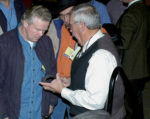Advertise Follow Us
Articles Tagged with ''deep digital flexor tendon''
Farrier-veterinarian Hans Castelijns shares some of the methods he’s used to correct and manage mismatched feet
Read More
The Farrier’s Role In Rehabilitation After Traumatic Injuries
Shoers are an important part of the overall equine health team
Read More
Exploring the Science Behind Wooden Shoes
Oklahoma veterinarian looks at why this system has proven an effective alternative treatment for laminitis and other cases
Read More
Deep Digital Flexor Tendon is Part of a Complex System
So DDFT injuries often involve or influence other lower-limb structures
Read More
Hoof Care and the Coffin Bone
Understanding the form and function of the distal phalanx is vital to keeping horses sound
Read More
Understanding Lameness Causes
A farrier says the ability to analyze the causes of lameness sets a farrier apart — and also protects him
Read More
Vet's Corner
Acute and Chronic Laminitis: An Overview
Individualized approach based on adherence to principles produces best results
Read More
Viewing Laminitis with Fresh Eyes
Massachusetts farrier offers a new perspective: Just for starters, he says P3 doesn’t rotate
Read More









